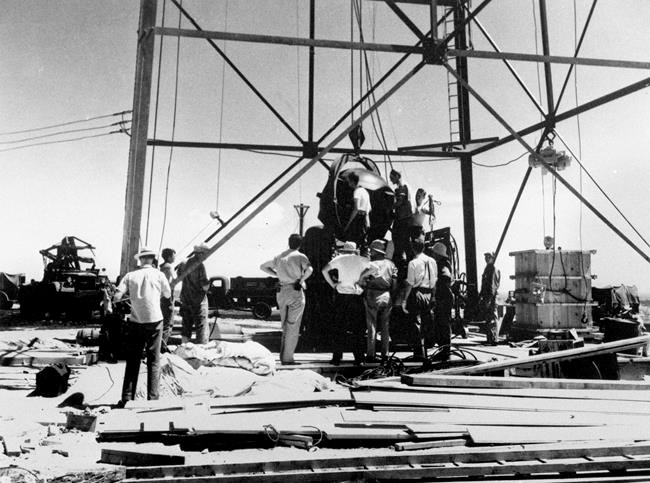ALBUQUERQUE, N.M. — In the desert northeast of Las Vegas, residents living along the Nevada-Arizona border would gather on their front porches for bomb parties or ride horses into the fields to watch as the U.S. government conducted atomic tests during a Cold War-era race to build up the nation's nuclear arsenal.
About 100 of those tests were aboveground, and U.S. Rep. Greg Stanton of Arizona testified during a congressional subcommittee hearing Wednesday that residents at the time marveled at the massive orange mushroom clouds billowing in the distance.
“They had no idea. They were never told that they were being exposed to dangerous cancer-causing radiation,” Stanton said. “As a direct result of the radiation exposure from these tests, thousands of Arizonans have suffered from cancer, entire families have suffered from cancer and far too many have died.”
He and others testified as part of a renewed push for compensation from the U.S. government following uranium mining and nuclear testing carried out during the Cold War.
Lawmakers from several Western states, advocacy groups and residents have been urging Congress to expand a payout program for years, and advocates say the latest push takes on added weight because the Radiation Exposure Compensation Act is set to expire next year. Wednesday’s hearing was the first on the issue since 2018, advocates said.
In New Mexico, about 40,000 people lived within a 50-mile (
The advocacy group has been trying for years to bring awareness to the lingering effects of nuclear fallout surrounding the Trinity Site. She told the committee that the bomb, being the first, was inefficient and sent a fireball of plutonium into the atmosphere.
“For days, radioactive ash fell from the sky and settled on everything — the soil, in the water, in the air, on the plants and on the skin of every living thing. It was a public health disaster of grand proportions,” Cordova testified.
The rural residents who lived off the land were never told about the test or warned about the potential dangers, she said.
Navajo Nation President Jonathan Nez testified about the environmental and health effects of decades of uranium mining on tribal land. He said more than 30 million tons of ore were extracted from Navajo lands to support U.S. nuclear activities, with many Navajos working in the mines without knowledge of the dangers.
He also pointed to a massive spill in 1979 that spewed radioactive tailings and wastewater onto tribal lands in the Church Rock area in western New Mexico.
A multibillion-dollar
U.S. Sen. Ben Ray Luján of New Mexico, who sponsored the bill to expand the program when he was in the House, recalled how a Navajo woman previously asked lawmakers whether they were waiting for the people who were exposed to radiation to die so the problem would go away.
“It's just not right,” Luján said, pointing to those on the Navajo Nation as well as people downwind in New Mexico, Idaho, Colorado, Montana, Nevada, Utah and Guam who are not eligible for payouts. “These people deserve justice.”
The compensation program covers workers who became sick as a result of the radiation hazards of their jobs and some of those who lived downwind of the Nevada Test Site, where the federal government conducted several hundred nuclear explosive tests over four decades. Excluded are residents near the Trinity Site in New Mexico, others who were downwind in Nevada and Arizona, miners who worked in the industry after 1971, veterans who cleaned up radioactive waste in the Marshall Islands and others.
The program has paid out nearly $2.5 billion on more than 37,000 claims since 1990. If Congress doesn't doesn't renew the program, no more claims can be filed after July 2022.
Congressional analysts and others could not answer the committee's questions about the potential number of new claims that could be filed if eligibility were expanded.
U.S. Rep. Hank Johnson, a Democrat from Georgia, said payouts so far amounted to a pittance when compared to the half-billion dollars the country expects to spend on maintaining its nuclear arsenal over the next decade.
Susan Montoya Bryan, The Associated Press



